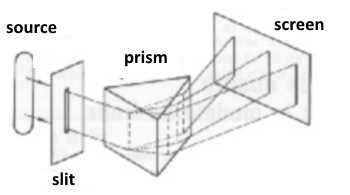








S is a source of white light . It sends light through a slit. A glass prism separates the white light into a visible spectrum on the screen

In the 19th century, physicists have proved:
- The white light is formed of a large multitude of electromagnetic waves of different wavelengths.
- Each color of the spectrum comes from a wave of different wavelength.
- The prism separates the waves according to their wavelength.
- The "red" waves have larger wavelengths than the "purple" waves. They are less deflected by the prism.
- The visible spectrum is only a small part of the spectrum of all electromagnetic waves:
 - Regardless of the wavelength of the light wave (therefore its color), the movement speed is constant in a vacuum.
- Regardless of the wavelength of the light wave (therefore its color), the movement speed is constant in a vacuum.
Speed of light in vacuum (and approximately in the air): $c$ $=$ $3.000\cdot10^8\frac{m}{s}$
Using the fundamental relations of the waves (2) and (4), we find:
$ c$ $ =$ $\frac {\lambda} {T}\;(5)$ $c$ $=$ $\lambda\cdot\nu\;(6)$

The wave theory of light was developed and perfected by James Clerk Maxwell . In the early 20th century, it seemed perfect. However there remained some disturbing facts to interpret .....